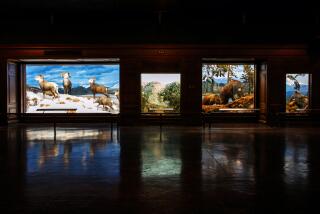A Day in the Marsh Finds Nature Group on the Right Track
- Share via
Jim Lowery knows how to transform a little patch of earth into a universe.
As the Friends of the Madrona Marsh watched Saturday, Lowery used the Torrance wetland to illustrate a story about the interrelationships of nature.
Lowery is a tracker. The science of studying animals through their tracks has been a longtime passion and more recently, a profession. Lowery, who lives in San Pedro, teaches courses in outdoor skills for the City of Rancho Palos Verdes and offers classes on his own.
The Friends of the Madrona Marsh--a group dedicated to preserving nature in the midst of Torrance’s expanse of concrete terrain--brought Lowery to their annual meeting Saturday.
Lowery helped the group of about 30 gain insight into the activities of the foxes, small rodents and other wildlife that inhabit the marsh. He also explained that tracking requires a mind set as well as skill; a willingness to connect with nature.
Lowery compared the mental state to that needed for martial arts, saying: “I might be agitated or preoccupied and miss something. If I can shut that part of the brain off, I start to see (natural) details.”
That attitude was essential Saturday in the Madrona Marsh, given the man-made assault on all sides. Traffic kept up a steady roar; planes swooped toward the nearby Torrance airport; oil derricks creaked incessantly.
Lowery used “tracking boxes,” strategically cleared areas that on Friday he had smoothed, then baited with food, to attract animals and provide a miniature classroom.
“The only way you learn is to get down on your hands and knees and put your nose in the dirt,” he said.
Lowery answered questions on how to distinguish between fox tracks and dog tracks (a fox’s toes are the same size) and demonstrated how to discern what an animal has eaten by breaking apart its droppings. He also stressed the need for viewing tracks in a wider context; pointing out fox tracks and a maze of mouse trails in heavy grass, he told the group this is prime hunting territory for foxes.
‘Land of Opportunity’
“Put yourself in the mind of a red fox as you come over this ridge,” he said. “What do you see? The land of opportunity. Dinner time.”
Watching the compact bearded man move across the marsh evoked images of the Native Americans who once hunted in the area. Lowery’s expertise derives from the teachings of an Apache Indian scout named Stalking Wolf, whose lore has been preserved by Tom Brown, an expert woodsman and Lowery’s mentor.
Lowery studied two years ago at the wilderness and survival school Brown runs in New Jersey. According to Lowery, Brown can track a mouse across leaves and can create a profile of an animal from its tracks: its size, age, sex, diet and more.
Brown has written a book, “Tracker” (Berkley: 1984), which recounts how as a child in New Jersey he met Stalking Wolf. The old man had come there after a lifetime of wandering. Brown befriended the man’s grandson, and the boys grew up learning the mysteries of the wilderness under the tutelage of Stalking Wolf.
Brown continued his training as an adult, surviving for a year in the Pine Barrens of New Jersey with a loincloth, a knife and Indian lore.
Lowery, who said he still has a great deal to learn, shares Brown’s craft with his students. One technique is called the “Wisdom of the Marks.” By making thumbprints at hour intervals in the same patch of ground, Lowery described how it is possible to determine the age of tracks through repeated comparison.
“I can establish the age of tracks to within a couple of hours,” he said. “But I’m always wrestling with doubt myself. Is that a fox track or is it my imagination? You reach a point of confidence after a while.”
Of the enthusiastic response to his classes, Lowery says: “People are responding with almost a craving to the alternative attitude of being more connected to the earth. The thing I try to get across is not to get too esoteric. You don’t have to figure out whether the animal is twitching its ear every time and struggle with it. The important thing is that you learn something every time out.”
Lowery’s trips away from the Los Angeles area to the deep wilderness are fewer now. They have been replaced by his growing interest in exploring the natural universe that survives in the urban sprawl of Southern California.
“Right now I think it’s more fun to slow down,” he said gesturing to the marsh. “That’s why an area like this is so great. You wouldn’t realize there’s such wildlife and calmness in an area surrounded by all this madness.”
More to Read
Sign up for Essential California
The most important California stories and recommendations in your inbox every morning.
You may occasionally receive promotional content from the Los Angeles Times.













